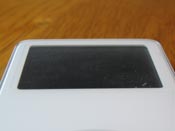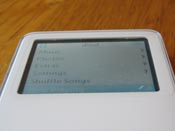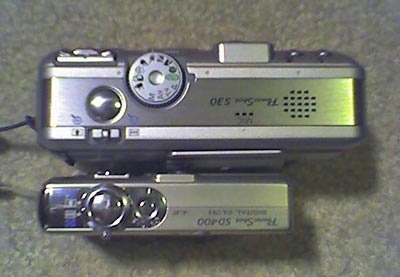Apparently the new iPod Nano is very susceptible to screen scratches (The Register article, Apple Discussions). My wife and I just bought a white Nano to replace her Mini, so these stories concerned me quite a bit—the last thing you’d want is to have the already-dimunitive screen scratched to the point where text and images are hard to discern. People are talking about returning their devices, class action lawsuits, etc. I really like the Nano, and would rather not return it. And since ours isn’t yet scratched, I thought I’d try some preventative medicine.
Knowing that it will be a while yet before any customized Nano screen protectors and/or cases ship, I took a (very minor) risk and thought I’d try to make my own. I started, of course, with someone else’s handiwork—these Treo screen protectors. These are probably the best screen protectors I’ve seen for the Treo; they’re basically invisible, and they don’t permanently mar your Treo’s screen if/when you remove them. I had a couple left over from my Treo (as the protectors come in a three-pack), so I did a bit of measuring and got out the scissors. A minute or so later, I had my completed Nano screen protector. I peeled off the backing, stuck it to the Nano’s front, and it worked perfectly — it basically disappeared once placed (though I intentionally cut the border slightly larger than the Nano’s screen). It’s hard to take pictures of, but I tried my best; click on either image below for a larger version:


As you can see, the protector is nearly invisible (and yes, the perfectionist in me has since gone back and re-centered it horizontally) whether the Nano is on or off. Since I did leave a slight border around the screen area, that edge is visible in the shots above (but it actually looks sort of natural there). Had I chosen to make the cover the exact size of the screen area, it would be even less visible. However, by leaving a border, I’ve made it easier to remove the cover in the future without risk of scratching the screen itself.
One of the reasons I like this screen protector a lot is that it’s easily removable and cleanable. The instructions state that you can lift the cover with a piece of scotch tape, but I’ve had better luck carefully sliding the edge of a sharp knife under the plastic, then prying up the corner. Once removed, you can wash the cover off with water to remove any dust, let it dry, and then put it back in place. I’ve had this one on and off a few times now, and (so far) it hasn’t left any marks on either the Nano’s case or screen.
This may not be a perfect solution, and who knows how well it will hold up over time, but for now, it seems like a reasonable investment to keep the Nano’s screen in scratch-free condition. As always, though, your mileage may vary and proceed at your own risk :).






 In case you missed the news, Apple today released
In case you missed the news, Apple today released